Cannabis Oil
Cannabis oils are highly concentrated extracts, they are usually made by adding cannabis plant material to a solvent, after the solvent has extracted the cannabinoids from the plant material the solvent is then evaporated away leaving behind the extracted concentrated cannabinoid oil.
Here is a brief guide to the different forms
BHO: Butane Honey Oil
This is extracted using butane gas. Butane has a low boiling point of 0.5 °C (31.1 °F) and using butane is very dangerous and it must always be performed outdoors. There have been many instances of fires caused by people using butane as an extraction solvent and some fire departments in the U.S. have gone so far as to issue warnings against its use. There are many companies who sell ready made Butane gas extraction
kits and they are readily available online. The best advice we can give is to not attempt this extraction process, if you decide to do so then wear protective clothing and always carry out the procedure outdoors away from any flame source.
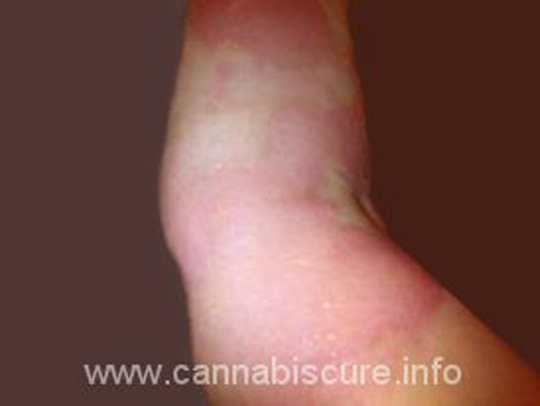
Injury from Butane gas extraction
These injuries were sustained attempting to make Butane extracted honey oil. The individuals cotton sports pants caught fire and injuries to the legs and groin area were extensive with serious burns to the penis and testicles, his hair caught fire and he sustained severe burns to the scalp and face resulting in noticeable scarring. Butane is a highly volatile gas and should never be used to extract cannabis oil for medical use, it is far too dangerous.
QWISO
This refers to Quick Wash Isopropyl, which literally means a ‘quick wash’ in Isopropyl alcohol, the cannabis is typically in the alcohol for under a minute, this method can produce a very high quality oil.
FECO
Full Extract Cannabis Oil, differs from QWISO as the cannabis has more of a soak than a wash, FECO fans often use Everclear® a 190° proof Grain Alcohol. It produces a very good quality oil.
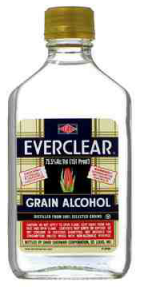
Everclear grain alcohol
Everclear grain alcohol, is the brand name of a colorless, unflavored, distilled beverage sold in some states in the U.S. and bottled at two different high strengths: 151-proof and 190-proof, meaning respectively 75.5% and 95% alcohol by volume, 190-proof spirits are the strongest that are available and they are ideal for this basic method of making cannabis oil. It is illegal to sell 190-proof Everclear in California, Florida, Hawaii, Iowa, Maine, Massachusetts, Minnesota, Nevada, New Hampshire, North Carolina and Virginia. It can be purchased in Ohio but only under severe restrictions. In Canada, Everclear is sold in the province of Alberta but not in other provinces. In British Columbia, it is available for purchase only with a permit for medical, research, or industrial use. Everclear is difficult to obtain in the E.U, it is however possible to distill your own solvent.
Hemp seed oil
This is usually referred to as ‘Cold pressed hemp oil’ and is made by ‘pressing’ non psychoactive cannabis hemp seeds, the extracted oil is very healthy and nutritious but it is not suitable for curing medical conditions as the seeds do not contain cannabinoids.
Cannabis Oil Infusion
Infused oil differs from an extracted oil in that it's not as concentrated; but Hemp or Olive oil infused with cannabis makes a versatile edible
Rick Simpson Oil
RSO refers to the oil promoted as a cure by cancer sufferer Rick Simpson, it is made by extracting cannabinoids by the use of a solvent, such oils are high in cannabinoid content. The use of the name ‘Hemp Oil’ to describe this extraction is confusing to say the least (see below). Rick’s process and instructional videos are available on his site www.phoenixtears.ca
Solvents commonly used to make cannabis oil
With all extraction methods, extreme caution must be taken when using solvents.
Naphtha (boiling point between 30 °C and 200 °C).
Naptha is extremely volatile and can explode on exposure to high temperature so great care must be taken when it is used. Naptha is recommended by Rick Simpson, however there are concerns expressed by some that naphtha can be carcinogenic. Some commonly available forms of Naptha contain impurities which may also have harmful properties of their own.
Acetone Boiling point 57 °C (135 °F).
Easily available as a solvent and degreaser, Acetone evaporates rapidly and it is a popular solvent and is recognized to have low acute and chronic toxicity if ingested and/or inhaled. Acetone has been internationally rated as a GRAS (Generally Recognized as Safe) substance for food use and is produced and disposed of in the human body through normal metabolic processes. The most hazardous property of acetone is its extreme flammability. At temperatures greater than acetone's flash point of -20 °C (-4 °F), air mixtures of between 2.5% and 12.8% acetone, by volume, may explode or cause a flash fire. Vapors can flow along surfaces to distant ignition sources and flash back
- See more at: //www.cannabiscure.info/files/cannabis_oil.htm#sthash.pBh1uNQK.dpuf
A Simple Extraction Method Using A Crock Pot or Rice Cooker
The better the quality of cannabis used, the better the resultant oil will be. Use top grade cannabis buds for the best results.
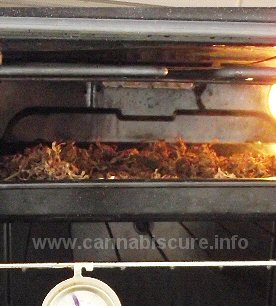
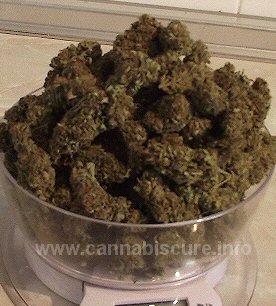
Completely dry the cannabis in an oven at 110ºC (230ºF). Place the bone dry cannabis material into a jar and cover with your solvent of choice, shake vigorously, the longer you agitate the mixture the more cannabinoids you will extract. However, if you use a polar solvent like Ethanol then short exposures are preferred as polar solvents also extract water solubles from the plant such as chlorophyll. Filter the plant solvent mixture, a cafetière is a convenient and quick way to remove the bulk of the plant material.
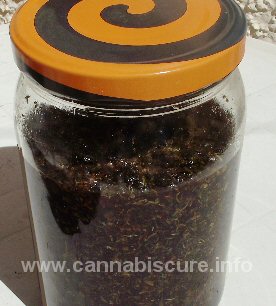
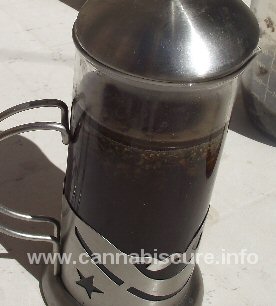
The final filtration is through a coffee filter which removes the empty trichomes and other fine contaminants. If you have filtered your solution correctly you will be left with an amber looking liquid.
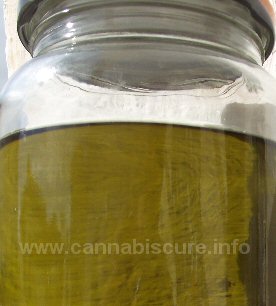
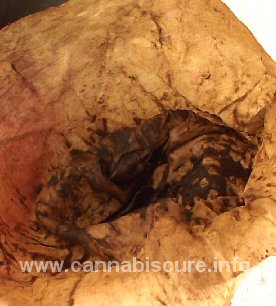
Pour the liquid into a Rice Cooker and with the lid removed, turn on. As the Rice Cooker heats up the solvent will start to boil. Be careful, boiling solvents are very volatile ALL EVAPORATION MUST BE DONE OUTDOORS – NO NAKED FLAMES! When the solvent has reduced in volume carefully pour into a good quality glass receptacle and complete the final evaporation on a hot plate or coffee warmer. As the volume reduces the mixture will be less volatile, the final evaporation process can take 24 to 48 hours, continue the evaporation process until there is no more activity.
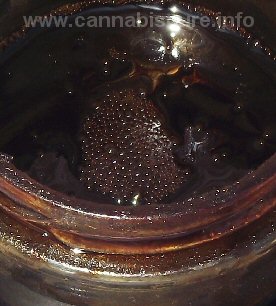
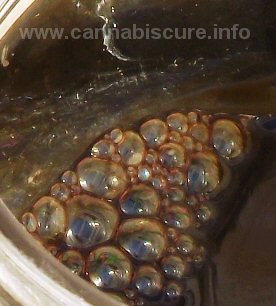
The colour of the final oil will vary depending on the strain used, the method, the solvent used and of course the skill of the oil maker.
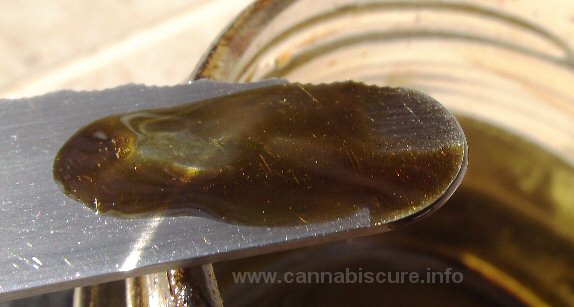
The oil is best stored in a syringe. Draw the oil up whilst slightly warm.
Cannabis Alcohol Tincture
Tinctures of cannabis have been made for hundreds of years and were one of the earliest forms of medicinal cannabis preparations.
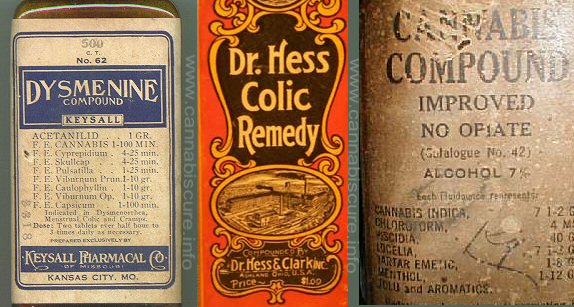
Cannabis tincture
The best tinctures are made from concentrated cannabinoid oil but if you do not have enough plant material to make a batch of oil then this simple method by José T. Gállego explains the process. It is easy to prepare a tincture or an oil from cannabis, that concentrates the active compounds of the plant. You need marijuana and ethyl alcohol of 96-99% (e.g. from the pharmacy), a glass that can be closed (e.g. jam jar), a coffee filter, a deep plate and a bottle with a dropper for storage and administration.
-Reduce the cannabis to small pieces and put it into the glass.
-Cover it with alcohol.
-Keep it in a dark and cool place for about a week.
-Shake it every day.
-Filter it using a coffee filter.
-Press the last drops of alcohol out of the plant material.
You may repeat this process several times, at least once, better twice. You may again put the cannabis into the glass and cover it with alcohol. Finally, put all the alcohol (it will have a green colour) into a deep plate. Keep it in a tempered and ventilated place so that some of the alcohol will be evaporated increasing the cannabinoids concentration of the tincture. This may take ten days. When enough alcohol is evaporated pour the extract into the bottle with the dropper. The cannabis tincture can be used directly, or dissolved in a drink or food, or vaporized. To vaporize the tincture a commercial vaporizer or the old silver paper system can be used. Form a teaspoon out of silver paper, put some drops of the tincture on it, carefully heat it with a candle until the alcohol evaporates - then inhale it using a small tube such as the body of a ball point pen. (Gállego JT: Tintura de cannabis. Canamo, No 46, July 2001:76-77)
Standardized Cannabis Tincture
With our assistance Bud Buddies have produced a cannabinoid oral mucosal mouth spray (which basically means you squirt it under your tongue). To produce a standardized tincture you must have access to a high quality oil made with a crock pot
extraction method previously shown, which has been HPLC tested. Such a report allows you to determine the cannabinoid profile and therefore produce standardized preparations

Test results
Bud Buddies sprayable tincture has an almost identical cannabinoid profile to Sativex - with each 10ml vial containing 270mg of CBD and 250mg of THC.
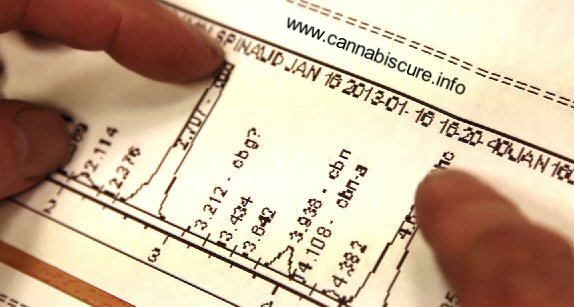
Test results
Two versions of cannabis tincture
Sativex Bud Buddies tincture
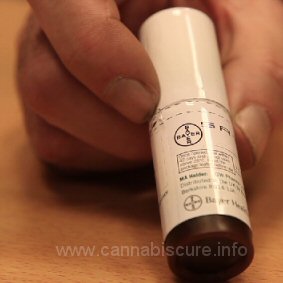
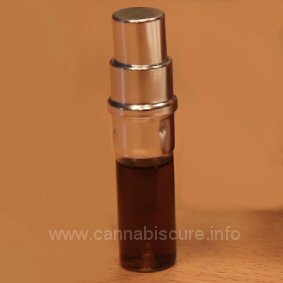
On the left is a pharmaceutical cannabinoid product called Sativex which cost $190.00 (approx.) per 10ml vial. On the right is our 10ml version which has exactly the same profile of THC and CBD, however, our version also contains the full profile of the other 80 beneficial cannabinoids and cost us just under $8.00 (€5.88) to produce (you read that correctly eight Dollars!). In making this medicinal tincture we committed a criminal offence, yet when you compare the costs of these two medicines, of which ours is arguably the more effective, you do question who the criminals really are.
Glycerine Cannabis Tincture
For recovering alcoholics or people who wish to avoid alcohol Glycerin is an ideal alternative to traditional alcohol based tinctures. For best results use 1/2 gallon (64 fl oz) of Food Grade Glycerin to (4 oz) of trim (or 2 ounces of quality bud) Set your crock pot to the lowest setting, this will usually be the ‘warm’ setting. Grind up your decarboxylated (heated on low in the oven to activate the cannabinoids) cannabis as finely as possible and add it to the glycerine in the crock pot. Let it sit for 12 – 24 hours, stirring occasionally. Use a cafetière to filter the glycerine, due to the density of the glycerine you will need to depress the plunger very slowly. Glycerine based cannabis
tinctures will not store as well as those made from alcohol therefore it is recommended that glycerine tinctures are stored in a refrigerator.
Source : //www.cannabiscure.info/files/cannabis_tincture.htm#sthash.eCRtz3Ky.dpuf




